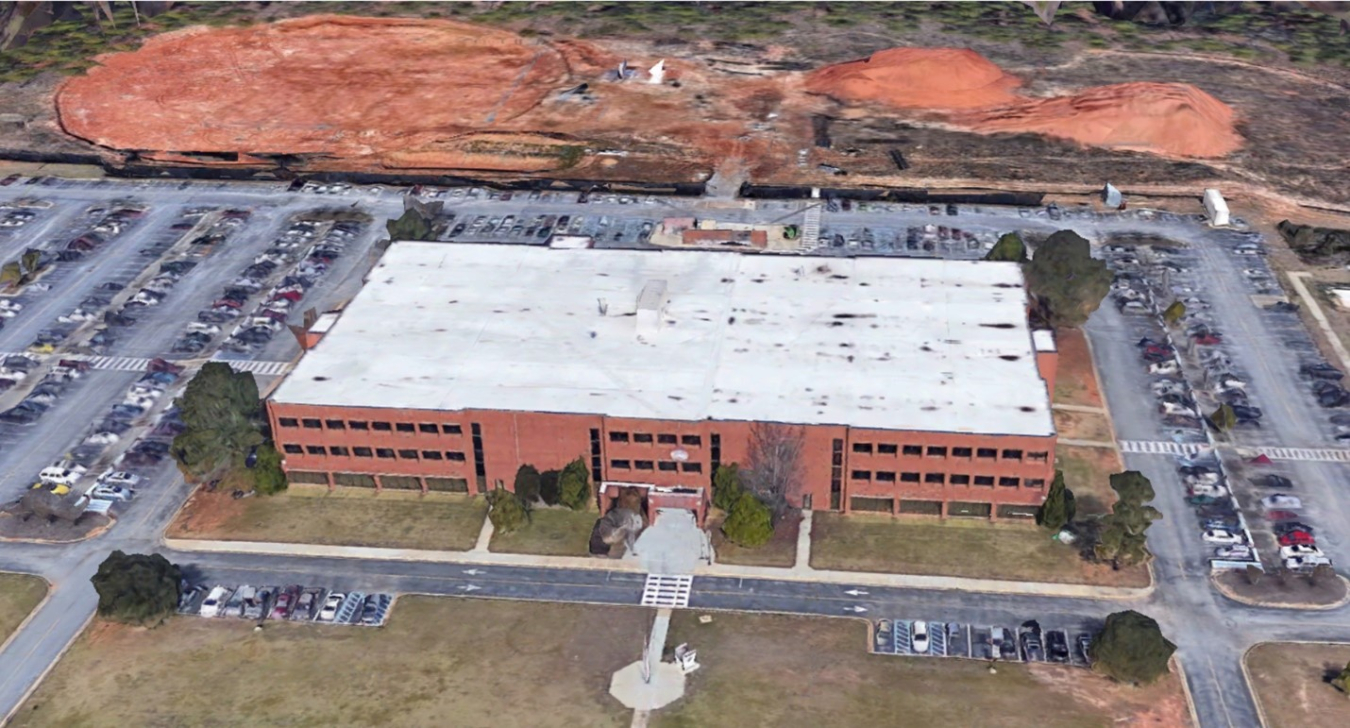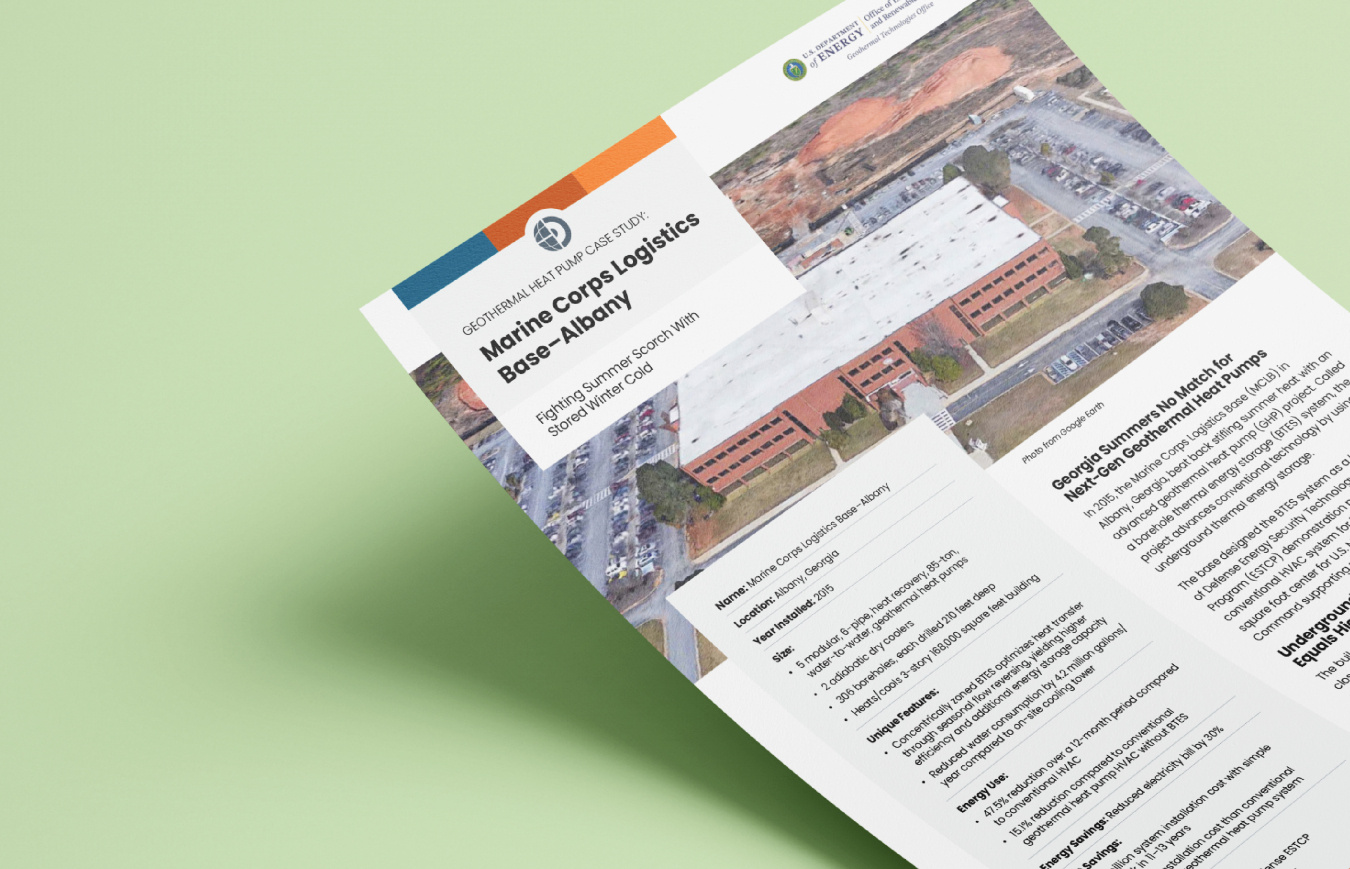
Photo from Google Earth
Fast Facts
Location: Albany, Georgia
Size:
- 5 modular, 6-pipe, heat recovery, 85-ton, water-to-water, geothermal heat pumps
- 2 adiabatic dry coolers
- 306 boreholes, each drilled 210 feet deep
- Heats/cools 3-story 168,000 square feet building
Unique Features:
- Concentrically zoned BTES optimizes heat transfer through seasonal flow reversing, yielding higher efficiency and additional energy storage capacity
- Reduced water consumption by 4.2 million gallons/year compared to on-site cooling tower
Download the full case study for additional fast facts.
Georgia Summers No Match for Next-Gen Geothermal Heat Pumps
In 2015, the Marine Corps Logistics Base (MCLB) in Albany, Georgia, beat back stifling summer heat with an advanced geothermal heat pump (GHP) project. Called a borehole thermal energy storage (BTES) system, the project advances conventional technology by using underground thermal energy storage.
The base designed the BTES system as a U.S. Department of Defense Energy Security Technology Certificate Program (ESTCP) demonstration project to replace the conventional HVAC system for Building 3700, a 168,000 square foot center for U.S. Marine Corps Logistics Command supporting nearly 800 base personnel.
Underground Thermal Battery Equals High Energy Efficiency
The building’s BTES system is a specialized geothermal closed-loop heat exchanger designed to efficiently store “cold” in the subsurface. The subsurface functions as a thermal battery, storing heat or cold underground, which increases the energy efficiency of the system over conventional geothermal heat pump HVAC systems.
The BTES system is adjacent to the building and spans two acres. The area consists of a compact, radial loop well field with 306 wells each 210 feet deep. A bullseye pattern of concentric thermal zones in the well field maximizes storage efficiency.
Cool Indoor Work Environment with Water Savings
In the building’s mechanical room, five modular heat recovery geothermal heat pumps replaced two centrifugal chillers and two condensing boilers. Once Georgia’s cooling season begins, these geothermal heat pumps withdraw the cool previously stored underground to efficiently keep MCLB personnel comfortable during hot Georgia summers.
Two adiabatic dry coolers that provide indirect evaporative cooling replaced the conventional HVAC cooling tower. This equipment stores cold winter air in the loop for summer use and rejects excess loop heat in the summer. Replacing the aging and maintenance-intensive conventional equipment saved 4.2 million gallons of HVAC water consumption during the first year of operation and eliminated the need for a water treatment system.

Taming the Heat By Constructing an Efficient Next-Gen Geothermal Heat Pump. When summer rages in southwest Georgia, MCLB personnel beat the heat with an efficient next-generation geothermal heat pump. The system uses 306 geothermal boreholes, zoned in concentric circles with reversing valves. Each borehole is 210 feet deep. During (left) and after (right) construction. Photos from Google Earth
Energy Use:
- 47.5% reduction over a 12-month period compared to conventional HVAC
Energy Savings:
- Reduced electricity bill by 30%
Cost Savings:
- $5.1 million system installation cost with simple payback in 11–13 years
Funding Sources:
- U.S. Department of Defense ESTCP and U.S. Department of Energy
Three More BTES Systems Added To Keep MCLB Albany Personnel Cool
The BTES project continues to keep personnel cool while providing energy savings and reducing water needs. Impressed with the results, MCLB Albany funded three new BTES systems to serve an additional 10 buildings and replace their conventional HVAC systems.
“I believe in geothermal heat pump technology to the point that I have one in my home. At the end of the day the closed-loop geothermal heat exchanger is plastic pipe and grout with no moving parts. It’s underground, highly resilient, and less complicated than a boiler, condensing unit, or cooling tower. It’s a good technology for almost any situation and geology. This project presented a wonderful opportunity to push ground loop design forward by showcasing an advanced design that makes a good system architecture great.”
Charles Hammock; Andrews, Hammock, & Powell, Inc.; Principal Investigator for Marine Corp Logistics Base-Albany BTES System
Contacts:
For questions about this case study, contact Timothy Tetreault, Energy and Water Program Manager, Environmental Security Technology Certification Program, timothy.j.tetreault.civ@mail.mil.
For any website technical issues or general questions about geothermal heat pumps, contact DOE.Geothermal@ee.doe.gov.
Printable Version
Download the printable Marine Corps Logistics Base Albany case study or visit the Geothermal Heat Pump Case Studies page to see more examples of geothermal heat pumps in action.


